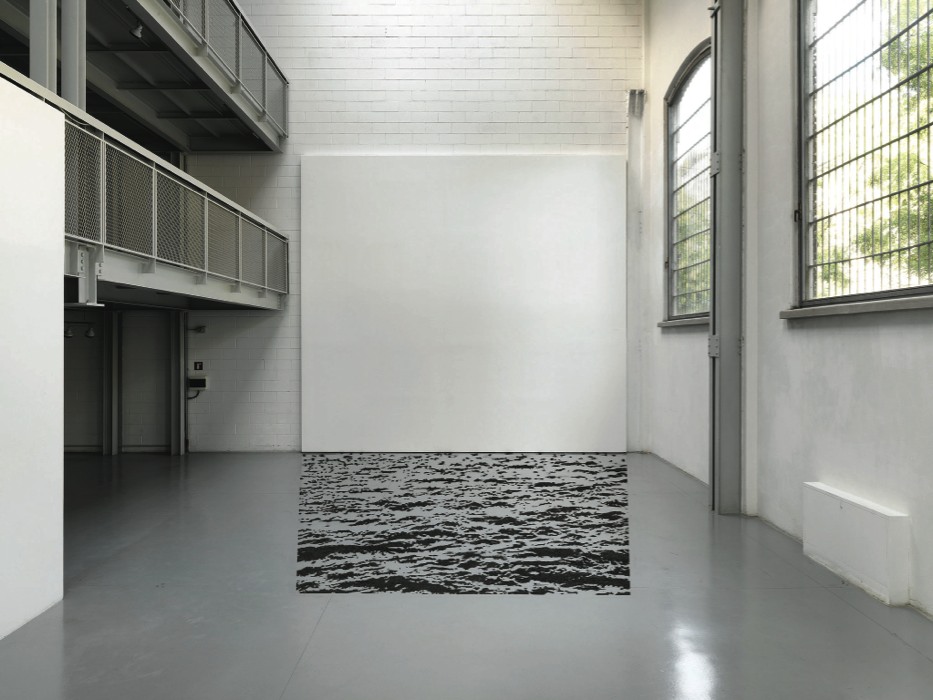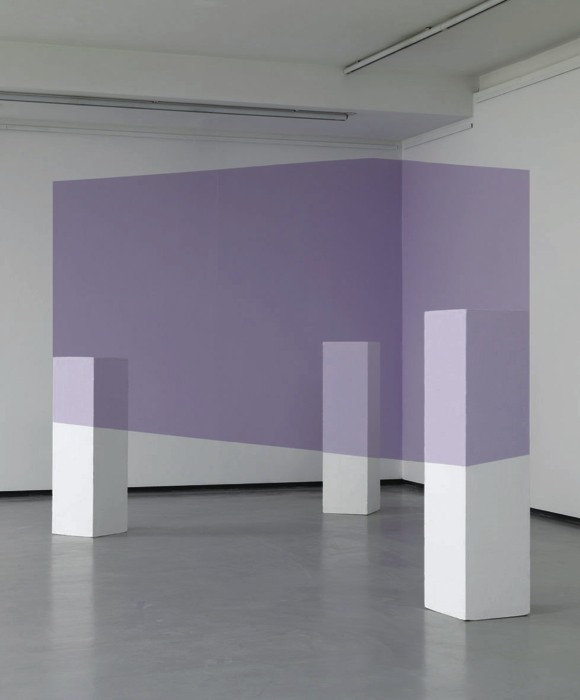Igor Eskinja’s use of humble materials – dust, ink, tape – and three-point perspective to create humorous, yet trenchant, critiques of the power of the image finds its simplest, and perhaps most effective, iteration in Made In:side (2007). Playfully pointing up the camera’s complicity in engineering reality, the series underscores the fallacy of equating the way things are represented with the way they are seen. Made In:side comprises a number of photographs documenting what appear to be graphically rendered cardboard-box sculptures of varying sizes and configurations superimposed onto an interior space. Whether inverted, partially disassembled, or stacked the boxed assemblages evince the difference and repetition of classic Minimalism rendered with an endearingly brash Pop aesthetic. Eskinja delineates the forms by applying strips of brown (and occasionally red, green, or black) tape to the walls and floor of a gallery.
Encountered from a random vantage point, whether in documentation or in person, the tape- drawn lines would appear disjointed and nonsensical. But by placing his camera at the exact point where the illusion coalesces, Eskinja summons it into order – into a simulation of three-dimensional reality that is, paradoxically, only preserved and perceptible via the two-dimensional photographs, which are the ultimate expression of Made In:side.
The representation, or simulation, of mass and depth is thus informed by Renaissance perspective techniques, rather than controlled through digital or darkroom manipulation. Although residing within an established history of subjects created for the camera, Eskinja’s objects do not posit themselves as “likenesses”; they are therefore not so much exercises in trompe-l’oeil as attempts to create a particular, self- contained reality. Even the title mimicking standard manufacturing information on commercial products, refers to this metaphorical “in side,” at the same time as referencing the interior architecture of the gallery.
At work here is a photography that has disassociated itself from matter in order to provide the viewer with a framework for re-envisioning the category of the sculptural. Notions of permanence and solidity are jettisoned in favor of a two- dimensional construct that posits space and matter as ephemeral, artificial, and provisional. Our perception has been, to return to a term used by the artist in connection with his work, “imagineered,” which is to say, directed through a flattened image-world of appearances, which we are in our media-saturated world inevitably more familiar with than direct contact.
Eskinja’s dry, humorous, and low- tech approach echoes that of 70s conceptual photographers like Douglas Huebler and Robert Cummings, but he also has much in common with the contemporary artists Vik Muniz, Gabriel Orozco, and Robin Rhode. Each in his own way uses the camera to enliven and remake matter as a two-dimensional fabrication, revealing connections between spaces and objects that may have been of no particular consequence before the picture was taken. Eskinja shares with Muniz in particular an engagement with the potential of photography arrived at through sculpture, and their artistic trajectories argue that dispensing with physicality allows for expanded interpretive and critical potential
Muniz’s turn in 1993 from sculpture to photography was provoked by reviewing photographic documentation of his objects, which rather than successfully replicating or resembling his mental impressions of the objects reinvented them, positioning them anew from different perspectives.
Photography thus began to seem ultimately the more versatile medium for its ability not only to convey mass and depth but also to add a further layer of meaning. Muniz has since used the camera and a succession of unconventional materials to take on the history of images, whether artistic or documentary, in the process transforming iron nails into fat, cushiony pillows; making needles and thread do service as credible renderings of Piranesi’s Carceri; or molding chocolate syrup into interpretations of black and white photographs from Life magazine (among other subjects). Although informed by a conscious acceptance of the inevitable failure of perfect iteration, the Made In:side photographs demonstrate a level of dexterity on the part of their author that is a standard requirement for the success of any magic trick. Art has always dealt with illusion. Contrary to deception and simulation, which carry negative connotations, illusion is enshrined within the art historical canon.
If deception entails concealing something from the viewer, illusion can sometimes makes things exceptionally plain. For, as Fredric Jameson points out in his 1998 essay, “The Existence of Italy,” “realism” is an “unstable” concept as the term “representation of reality” suggests, juxtaposing as it does an incompatible aesthetic concept (“representation”) with an epistemological claim (“reality”): If realism validates its claim to being a correct or true representation of the world, it thereby ceases to be an aesthetic mode of representation and falls out of art altogether.
If, on the other hand, the artistic devices and technological equipment whereby it captures that truth of the world are explored and stressed and foregrounded, “realism” will stand unmasked as a mere reality – or realism – effect, the reality it purported to deconceal falling at once into the sheerest representation and illusion. In Eskinja’s work, as in Muniz’s, it is these illusions that serve to make people aware of the fallacies of visual information. To quote Muniz, “I don’t want people to simply see a representation of something. I want them to feel how it happens. Eskinja also makes no secret of the mechanics of his illusion. Documentation of his process is readily available, although it is unable to override viewers’ certainties about their faithful perception of the photographed scene proving that what we see is merely what our eyes intend to discover. A form of “meta-illusion,” then, his box assemblages reveal the “architecture of our concept of truth” rather than fooling our eyes.
The ambiguity of the relationship of image to sculpture provokes further questioning of the relationship of images to accepted reality. Responding to the Jamesonian inquiry “how to escape from the image by means of the image?” Eskinja prompts us to rethink images and their meanings, a conceptual approach that may on the surface appear rather simplistic, but that actually challenges core (mis)assumptions about photographic representation. We have known for some time that seeing isn’t necessarily believing, but is seems the “image, has become more real than its own referent. Paradoxically, though the truth offered by the photograph is absolutely credible, the truth of the scene cannot be grasped here. ”5In this way Made In:side could be seen as a Minimalist parable illustrating Baudrillard’s claim, argued in his 1985 treatise “Simulacra and Simulation,” that modern society has replaced all reality and meaning with symbols and signs, and that the human experience is not of reality but of a simulation of reality.
Our age of mechanical reproduction is consumed with appearance and surface, and “truth”, or what was formerly called “authenticity”, is relative. Eskinja work constitutes a conscious incidence in the history of events removed from our direct experience, mirroring a reality as fragmented as contemporary life. If image is content, therefore, Eskinja’s constructions are not really about form but about image. And his improbable images, reinserted into the broader context of the media world, become suspect, infecting our perception by rendering all other images suspicious.
Leigh Markopoulos









